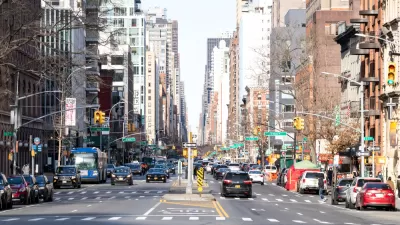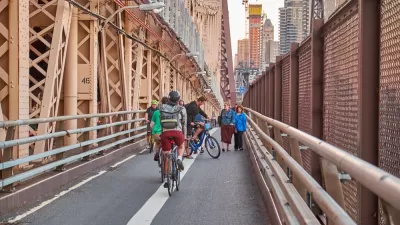New data from New York's Transportation Department shows that although miles of Manhattan street space have been turned over to bikes and pedestrians since 2008, average traffic speeds have actually increased, despite a consistent volume of vehicles.
Something funny has happened south of 60th Street in Manhattan, where new bike lanes and pedestrian plazas have popped up in recent years. New data shows that Mayor Bloomberg's "war on cars" has actually been a boon to traffic flow, benefiting the city's many modes of transportation.
"Citing GPS data from the city’s yellow cabs, the Bloomberg administration said that average traffic speeds in Manhattan’s primary central business district, south of 60th Street, had increased nearly 7 percent since 2008," reports Matt Flegenheimer.
“We’re not, despite our reputation, trying to take from one and give to the other,” Bruce Schaller, the department’s deputy commissioner for traffic and planning, said. “It isn’t a zero-sum game.”
Not all are convinced of the benevolent impact of expanding bike and pedestrian infrastructure, however. "Christopher McBride, a transportation specialist with AAA New York, noted that while traffic volumes had been fairly consistent in recent years, they had decreased significantly compared with 10 to 15 years ago, suggesting that some commuters had simply given up on Midtown driving in the Bloomberg years," notes Flegenheimer.
“It is more of a hassle now than ever to drive into the central business district,” he said. “Some of these changes that have occurred, they’re more intimidating for drivers. And a lot of parking has been eliminated.”
FULL STORY: In Bloomberg’s City of Bike Lanes, Data Show, Cabs Gain a Little Speed

Maui's Vacation Rental Debate Turns Ugly
Verbal attacks, misinformation campaigns and fistfights plague a high-stakes debate to convert thousands of vacation rentals into long-term housing.

Planetizen Federal Action Tracker
A weekly monitor of how Trump’s orders and actions are impacting planners and planning in America.

In Urban Planning, AI Prompting Could be the New Design Thinking
Creativity has long been key to great urban design. What if we see AI as our new creative partner?

King County Supportive Housing Program Offers Hope for Unhoused Residents
The county is taking a ‘Housing First’ approach that prioritizes getting people into housing, then offering wraparound supportive services.

Researchers Use AI to Get Clearer Picture of US Housing
Analysts are using artificial intelligence to supercharge their research by allowing them to comb through data faster. Though these AI tools can be error prone, they save time and housing researchers are optimistic about the future.

Making Shared Micromobility More Inclusive
Cities and shared mobility system operators can do more to include people with disabilities in planning and operations, per a new report.
Urban Design for Planners 1: Software Tools
This six-course series explores essential urban design concepts using open source software and equips planners with the tools they need to participate fully in the urban design process.
Planning for Universal Design
Learn the tools for implementing Universal Design in planning regulations.
planning NEXT
Appalachian Highlands Housing Partners
Mpact (founded as Rail~Volution)
City of Camden Redevelopment Agency
City of Astoria
City of Portland
City of Laramie





























